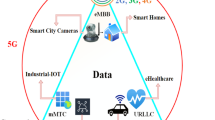Abstract
In this paper, by introducing orthogonal space-time coding scheme, the multiuser CDMA systems with different space time codes are given, and corresponding system performance is investigated over Rayleigh fading channel. A low-complexity multiuser receiver scheme is developed for space-time coded CDMA systems. The scheme can make full use of the complex orthogonality of space-time coding to simplify the high decoding complexity of the existing scheme. Compared to the existing scheme with exponential decoding complexity, it has linear decoding complexity. Based on the performance analysis and mathematical calculation, average bit error rate (BER) of the system is derived in detail, and tight closed-form approximation expressions of BER are attained. Simulation results on average BER are in agreement with the theory analysis. The results show that the proposed scheme can achieve almost the same performance as the existing scheme. Moreover, on the condition of same system throughput and concatenation of channel code, the given full-rate space-time coded CDMA system has lower BER than the full-diversity space-time coded CDMA systems.
Similar content being viewed by others
References
Paulraj A J, Gore D A, Nabar R U, et al. An overview of MIMO communications-A key to gigabit wireless. Proc IEEE, 2004, 92(2): 198–218
Maaref A, Aissa S. Capacity of space-time block codes in MIMO Rayleigh fading channel with adaptive transmission and estimation errors. IEEE TransWirel Commun, 2005, 4(5): 2568–2578
Jafarkhani H. A quasi-orthogonal space-time block code. IEEE Trans Commnu, 2001, 49(1): 1–4
Tarokh V, Jafarkhani H, Calderbank A R. Space-time block codes from orthogonal designs. IEEE Trans Inf Theory, 1999, 45(5): 1456–1467
Yu X B, Xu D Z, Bi G G. Full-rate complex orthogonal spacetime block code for multiple antennas. Wirel Person Commun, 2007, 40(1): 81–89
Larsson E G, Stoica P. Space-time Block Coding for Wireless Communications. Cambridge: Cambridge University Press, 2003
Ganesan G, Stoica P. Space-time block codes: a maximum SNR approach. IEEE Trans Inf Theory, 2001, 47(6): 2335–2367
Sandhu S, Paulraj A. Space-time block codes: A capacity perspective. IEEE Commun Lett, 2000, 4(12): 384–386
Li H B, Li J. Differential and coherent decorrelating multiuser receivers for space-time coded CDMA systems. IEEE Trans Signal Process, 2002, 50(10): 2529–2536
Tarokh V, Jafarkhani H, Calderbank A R. Space-time block coding for wireless communications: performance results. IEEE J Select Areas Commun, 1999, 17(3): 451–460
Liew T H, Hanzo L. Space-time codes and concatenated channel codes for wireless communications. Proc IEEE, 2002, 90(2): 187–219
Verdu S. Multiuser Detection. Cambridge: Cambridge University Press, 1998
Proakis J G. Digital Communications. 4th ed. New York: McGraw-Hill, 2001
Lu J, Letaief K B, Chuang J C -I, et al. M-PSK and M-QAM BER computation using signal-space concepts. IEEE Trans Commun, 1999, 47(2): 181–184
Gradshteyn I S, Ryzhik I M. Table of Integrals, Series, and Products. 5th ed. San Diego, CA: Academic, 2000
Simon M K, Hinedi S M, Lindsey W C. Digital Communication Techniques Signal Design and Detection. Englewood Cliffs: NJ: Prentice-Hall, 1995
Author information
Authors and Affiliations
Corresponding author
Additional information
Supported by the China Postdoctoral Science Foundation (Grant No. 2005038242), the open research fund of National Mobile Communications Research Laboratory, Southeast University (Grant No. N200904), and the startup fund of Nanjing University of Aeronautics and Astronautics (Grant No. S0855-041)
Rights and permissions
About this article
Cite this article
Yu, X., Dong, T. & Bi, G. Performance of multiuser CDMA system with space-time block coding in MIMO Rayleigh fading channels. Sci. China Ser. F-Inf. Sci. 52, 2296–2307 (2009). https://doi.org/10.1007/s11432-009-0216-4
Received:
Accepted:
Published:
Issue Date:
DOI: https://doi.org/10.1007/s11432-009-0216-4




